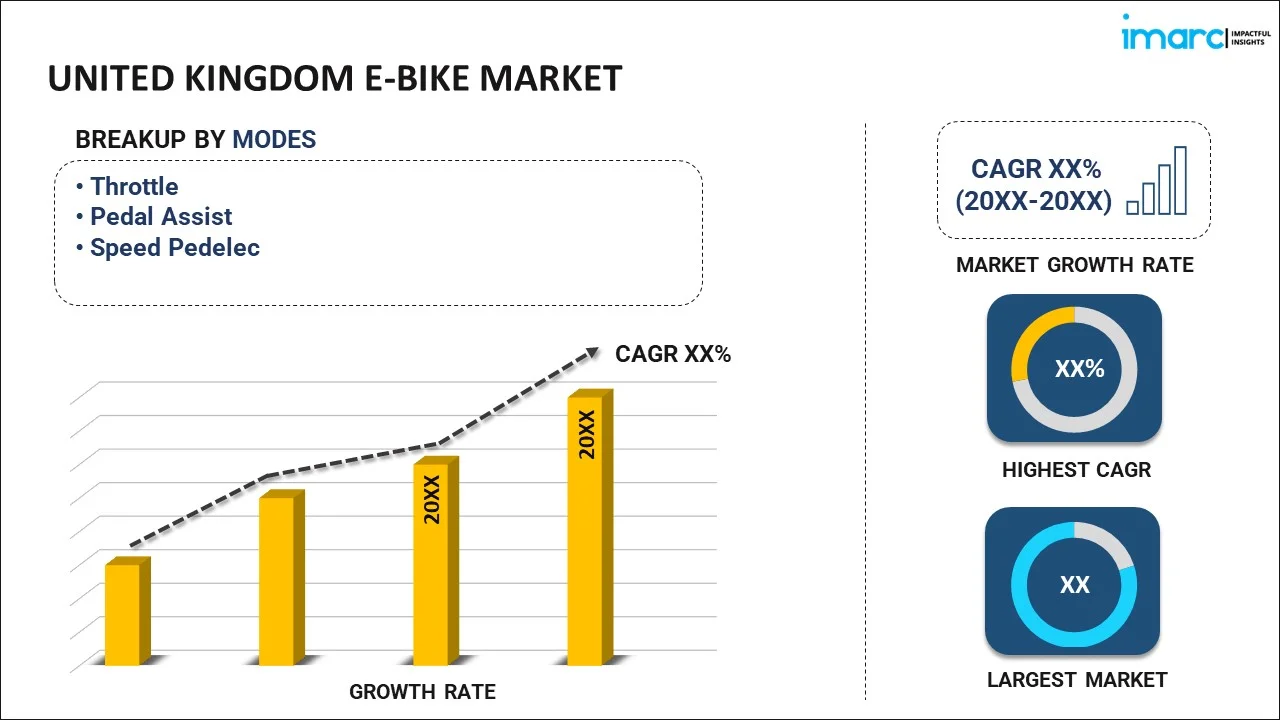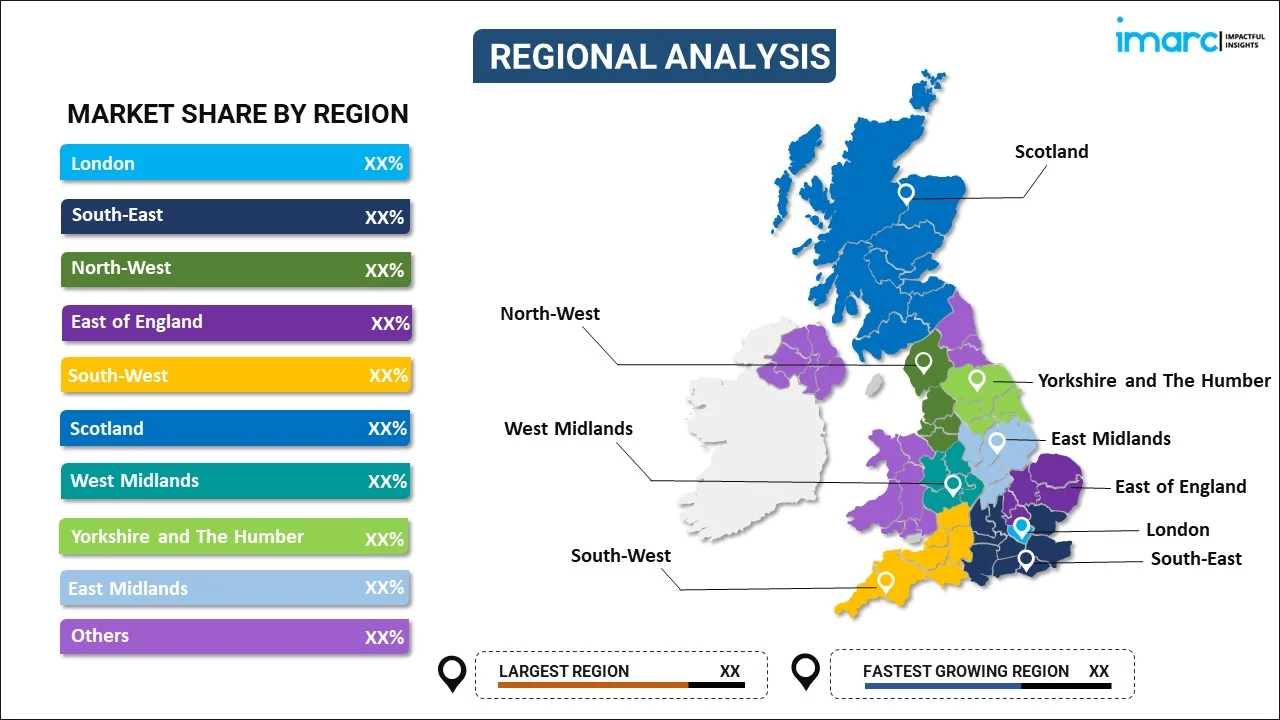
United Kingdom E-bike Market Report by Mode (Throttle, Pedal Assist, Speed Pedelec), Motor Type (Hub Motor, Mid Drive), Battery Type (Lead Acid, Lithium Ion, and Others), Class (Class I, Class II, Class III), Design (Foldable, Non-Foldable), Application (Mountain/Trekking Bikes, City/Urban, Cargo), and Region 2024-2032
United Kingdom E-bike Market Overview:
The United Kingdom e-bike market is projected to exhibit a growth rate (CAGR) of 9.40% during 2024-2032. Increasing environmental awareness, government incentives, urbanization, traffic congestion, advancements in e-bike technology, rising health and fitness consciousness, the need for sustainable transportation, and the expanding network of cycling infrastructure are some of the key factors strengthening the market growth.
|
Report Attribute
|
Key Statistics
|
|---|---|
|
Base Year
|
2023 |
|
Forecast Years
|
2024-2032
|
|
Historical Years
|
2018-2023
|
| Market Growth Rate (2024-2032) | 9.40% |
United Kingdom E-bike Market Trends:
Rising environmental awareness
Increasing environmental awareness and the push towards sustainable transportation are major trends driving the adoption of e-bikes. As concerns over climate change and environmental degradation intensify, consumers and policymakers are seeking greener alternatives to traditional fossil fuel-powered vehicles. E-bikes offer an eco-friendly mode of transportation that reduces carbon emissions, decreases reliance on non-renewable energy sources, and promotes cleaner urban environments. For instance, Norwegian-German startup CityQ will launch car-like e-bikes in the UK, Germany, Benelux, and Scandinavia in 2024, offering sustainable, congestion-reducing alternatives with passenger and cargo models, featuring seating, weather protection, and a digital powertrain for eco-friendly urban mobility. Public awareness campaigns and corporate responsibility programs further encourage individuals to opt for e-bikes as part of their commitment to environmental conservation, aiding the market growth.
Technological innovation
Advancements in e-bike technology are significantly enhancing their appeal and usability. Innovations in battery technology, motor efficiency, and lightweight materials have led to the development of more powerful, longer-lasting, and lighter e-bikes. Modern e-bikes offer extended battery life, lesser charging times, and improved performance, making them a viable option for daily commuting and long-distance travel. Furthermore, the addition of clever features like customizable riding modes, smartphone connectivity, and global positioning system (GPS) navigation has enhanced the user experience and drawn in tech-savvy customers. These technological advancements improve the functionality and convenience of e-bikes and address previous limitations, making them more attractive to a broader audience bolstering the market growth.
Rise in urbanization
Urban residents are increasingly compelled to seek alternative transportation due to the growth in urbanization and the worsening traffic congestion. With cities becoming more densely populated, traditional car commuting is often impractical due to traffic jams, parking difficulties, and rising fuel costs. An economical and useful way to navigate through crowded cities is with an e-bike. They retain the benefits of traditional bicycles, like maneuverability and ease of parking, with the physical exertion barrier associated with cycling. Moreover, the compact design of e-bikes allows riders to combine them with public transport, offering greater flexibility for multi-modal commuting. Urban planners and city authorities are also recognizing the potential of e-bikes to alleviate traffic congestion and are increasingly investing in dedicated cycling lanes and bike-sharing schemes, further creating a positive outlook for market expansion.
United Kingdom E-bike Market News:
- In April 2024, Swifty launched the UK's first street-legal e-scooter, the GO GT500, featuring a 25-mile range and a top speed of 24 mph. Powered by a 500-watt motor, the GO GT500 is classified as a Stand-On Moped by the Driver and Vehicle Standards Agency (DVSA), adhering to the same safety and regulatory standards as L1e category vehicles.
United Kingdom E-bike Market Segmentation:
IMARC Group provides an analysis of the key trends in each segment of the market, along with forecasts at the country level for 2024-2032. Our report has categorized the market based on mode, motor type, battery type, class, design, and application.
Mode Insights:

- Throttle
- Pedal Assist
- Speed Pedelec
The report has provided a detailed breakup and analysis of the market based on the mode. This includes throttle, pedal assist and speed pedelec.
Motor Type Insights:
- Hub Motor
- Mid Drive
A detailed breakup and analysis of the market based on the motor type have also been provided in the report. This includes hub motor and mid drive.
Battery Type Insights:
- Lead Acid
- Lithium Ion
- Others
The report has provided a detailed breakup and analysis of the market based on the battery type. This includes lead acid, lithium ion, and others.
Class Insights:
- Class I
- Class II
- Class III
A detailed breakup and analysis of the market based on the class have also been provided in the report. This includes class I, class II, and class III.
Design Insights:
- Foldable
- Non-Foldable
The report has provided a detailed breakup and analysis of the market based on the design. This includes foldable and non-foldable.
Application Insights:
- Mountain/Trekking Bikes
- City/Urban
- Cargo
A detailed breakup and analysis of the market based on the application have also been provided in the report. This includes mountain/trekking bikes, city/urban, and cargo.
Regional Insights:

- London
- South East
- North West
- East of England
- South West
- Scotland
- West Midlands
- Yorkshire and The Humber
- East Midlands
- Others
The report has also provided a comprehensive analysis of all the major regional markets, which include London, South East, North West, East of England, South West, Scotland, West Midlands, Yorkshire and The Humber, East Midlands, and Others.
Competitive Landscape:
The market research report has also provided a comprehensive analysis of the competitive landscape. Competitive analysis such as market structure, key player positioning, top winning strategies, competitive dashboard, and company evaluation quadrant has been covered in the report. Also, detailed profiles of all major companies have been provided.
United Kingdom E-bike Market Report Coverage:
| Report Features | Details |
|---|---|
| Base Year of the Analysis | 2023 |
| Historical Period | 2018-2023 |
| Forecast Period | 2024-2032 |
| Units | Million US$ |
| Scope of the Report | Exploration of Historical Trends and Market Outlook, Industry Catalysts and Challenges, Segment-Wise Historical and Future Market Assessment:
|
| Modes Covered | Throttle, Pedal Assist, Speed Pedelec |
| Motor Types Covered | Hub Motor, Mid Drive |
| Battery Types Covered | Lead Acid, Lithium Ion, Others |
| Classes Covered | Class I, Class II, Class III |
| Designs Covered | Foldable, Non-Foldable |
| Applications Covered | Mountain/Trekking Bikes, City/Urban, Cargo |
| Regions Covered | London, South East, North West, East of England, South West, Scotland, West Midlands, Yorkshire and The Humber, East Midlands, Others |
| Customization Scope | 10% Free Customization |
| Post-Sale Analyst Support | 10-12 Weeks |
| Delivery Format | PDF and Excel through Email (We can also provide the editable version of the report in PPT/Word format on special request) |
Key Questions Answered in This Report:
- How has the United Kingdom e-bike market performed so far and how will it perform in the coming years?
- What has been the impact of COVID-19 on the United Kingdom e-bike market?
- What is the breakup of the United Kingdom e-bike market on the basis of mode?
- What is the breakup of the United Kingdom e-bike market on the basis of motor type?
- What is the breakup of the United Kingdom e-bike market on the basis of battery type?
- What is the breakup of the United Kingdom e-bike market on the basis of class?
- What is the breakup of the United Kingdom e-bike market on the basis of design?
- What is the breakup of the United Kingdom e-bike market on the basis of application?
- What are the various stages in the value chain of the United Kingdom e-bike market?
- What are the key driving factors and challenges in the United Kingdom e-bike?
- What is the structure of the United Kingdom e-bike market and who are the key players?
- What is the degree of competition in the United Kingdom e-bike market?
Key Benefits for Stakeholders:
- IMARC’s industry report offers a comprehensive quantitative analysis of various market segments, historical and current market trends, market forecasts, and dynamics of the United Kingdom e-bike market from 2018-2032.
- The research report provides the latest information on the market drivers, challenges, and opportunities in the United Kingdom e-bike market.
- Porter's five forces analysis assist stakeholders in assessing the impact of new entrants, competitive rivalry, supplier power, buyer power, and the threat of substitution. It helps stakeholders to analyze the level of competition within the United Kingdom e-bike industry and its attractiveness.
- Competitive landscape allows stakeholders to understand their competitive environment and provides an insight into the current positions of key players in the market.
Need more help?
- Speak to our experienced analysts for insights on the current market scenarios.
- Include additional segments and countries to customize the report as per your requirement.
- Gain an unparalleled competitive advantage in your domain by understanding how to utilize the report and positively impacting your operations and revenue.
- For further assistance, please connect with our analysts.
 Inquire Before Buying
Inquire Before Buying
 Speak to an Analyst
Speak to an Analyst
 Request Brochure
Request Brochure
 Request Customization
Request Customization




.webp)




.webp)












